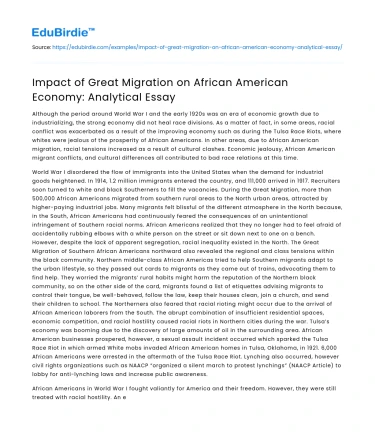Although the period around World War I and the early 1920s was an era of economic growth due to industrializing, the strong economy did not heal race divisions. As a matter of fact, in some areas, racial conflict was exacerbated as a result of the improving economy such as during the Tulsa Race Riots, where whites were jealous of the prosperity of African Americans. In other areas, due to African American migration, racial tensions increased as a result of cultural clashes. Economic jealousy, African American migrant conflicts, and cultural differences all contributed to bad race relations at this time.
World War I disordered the flow of immigrants into the United States when the demand for industrial goods heightened. In 1914, 1.2 million immigrants entered the country, and 111,000 arrived in 1917. Recruiters soon turned to white and black Southerners to fill the vacancies. During the Great Migration, more than 500,000 African Americans migrated from southern rural areas to the North urban areas, attracted by higher-paying industrial jobs. Many migrants felt blissful of the different atmosphere in the North because, in the South, African Americans had continuously feared the consequences of an unintentional infringement of Southern racial norms. African Americans realized that they no longer had to feel afraid of accidentally rubbing elbows with a white person on the street or sit down next to one on a bench. However, despite the lack of apparent segregation, racial inequality existed in the North. The Great Migration of Southern African Americans northward also revealed the regional and class tensions within the black community. Northern middle-class African Americas tried to help Southern migrants adapt to the urban lifestyle, so they passed out cards to migrants as they came out of trains, advocating them to find help. They worried the migrants’ rural habits might harm the reputation of the Northern black community, so on the other side of the card, migrants found a list of etiquettes advising migrants to control their tongue, be well-behaved, follow the law, keep their houses clean, join a church, and send their children to school. The Northerners also feared that racial rioting might occur due to the arrival of African American laborers from the South. The abrupt combination of insufficient residential spaces, economic competition, and racial hostility caused racial riots in Northern cities during the war. Tulsa’s economy was booming due to the discovery of large amounts of oil in the surrounding area. African American businesses prospered, however, a sexual assault incident occurred which sparked the Tulsa Race Riot in which armed White mobs invaded African American homes in Tulsa, Oklahoma, in 1921. 6,000 African Americans were arrested in the aftermath of the Tulsa Race Riot. Lynching also occurred, however civil rights organizations such as NAACP “organized a silent march to protest lynchings” (NAACP Article) to lobby for anti-lynching laws and increase public awareness.
Save your time!
We can take care of your essay
- Proper editing and formatting
- Free revision, title page, and bibliography
- Flexible prices and money-back guarantee
African Americans in World War I fought valiantly for America and their freedom. However, they were still treated with racial hostility. An example is the history of the Hellfighters, a highly renowned African American regiment in World War I. “Even before combat, the regiment faced unjust challenges from fellow Americans.” (Harlem Hellfighters Article) They trained for war in a Jim Crow area of South Carolina, confronted by racism and unusual military discipline.
The Harlem Renaissance was influential in the recognition of African American culture in music, literature, and intellectuality. They expressed their feelings through music, poetry, and art. The Hellfighters’ story of their valor during World War I brought mixed results as the veterans returned to America. However, Noble Sissle carried the legacy of the Hellfighters as a singer and songwriter and released his 1921 musical, Shuffle Along, which “became one of the Harlem Renaissance’s major works.” (Harlem Hellfighters Article) The Harlem Renaissance built more confidence and pride in the African American community to be themselves. They felt stronger to speak up for their rights and culture to show individualism instead of completely being conformed.
The period around World War I and the early 1920s was a bad time for race relations in the United States because of the enviousness of prospering African American economy, the Great Migration, and cultural differences. Encouragement of African American entrepreneurship and the Great Migration influenced racial tensions such as the Tulsa Race Riot. Although, the Harlem Renaissance improved recognition in African American culture, cultural clashes where African Americans expressed their feelings through music, art, and literature also caused racial tensions.






 Stuck on your essay?
Stuck on your essay?

